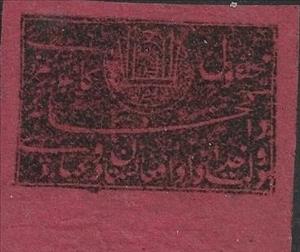Stamp: National Coat of Arms, undated (Afghanistan 1898)
National Coat of Arms, undated (Afghanistan 1898)
01 January (Afghanistan ) within release Registration stamps goes into circulation Stamp National Coat of Arms, undated face value 2 Afghan abbasi
| Stamp National Coat of Arms, undated in catalogues | |
|---|---|
| Michel: | Mi: AF 169 |
| Stamp Number: | Sn: AF F6 |
Stamp is horizontal format.
Also in the issue Registration stamps:
- Stamp - Mirab Mosque, Readingdesk and Flags face value 2;
- Stamp - Mirab Mosque, Readingdesk and Flags face value 2;
- Stamp - Mirab Mosque, Readingdesk and Flags face value 2;
- Stamp - National Coat of Arms, undated face value 2;
- Stamp - National Coat of Arms, undated face value 2;
- Stamp - National Coat of Arms, undated face value 2;
- Stamp - National Coat of Arms, undated face value 2;
Stamp National Coat of Arms, undated it reflects the thematic directions:
A flag is a piece of fabric (most often rectangular or quadrilateral) with a distinctive design that is used as a symbol, as a signaling device, or as decoration. The term flag is also used to refer to the graphic design employed, and flags have since evolved into a general tool for rudimentary signalling and identification, especially in environments where communication is similarly challenging (such as the maritime environment where semaphore is used). National flags are patriotic symbols with varied wide-ranging interpretations, often including strong military associations due to their original and ongoing military uses. Flags are also used in messaging, advertising, or for other decorative purposes. The study of flags is known as vexillology, from the Latin word vexillum, meaning flag or banner.
Mosquitoes, the Culicidae, are a family of small flies consisting of 3,600 species. The word mosquito (formed by mosca and diminutive -ito) is Spanish and Portuguese for little fly. Mosquitoes have a slender segmented body, one pair of wings, three pairs of long hair-like legs, and specialized, highly elongated, piercing-sucking mouthparts. All mosquitoes drink nectar from flowers; females of some species have in addition adapted to drink blood. The group diversified during the Cretaceous period. Evolutionary biologists view mosquitoes as micropredators, small animals that parasitise larger ones by drinking their blood without immediately killing them. Medical parasitologists view mosquitoes instead as vectors of disease, carrying protozoan parasites or bacterial or viral pathogens from one host to another.

